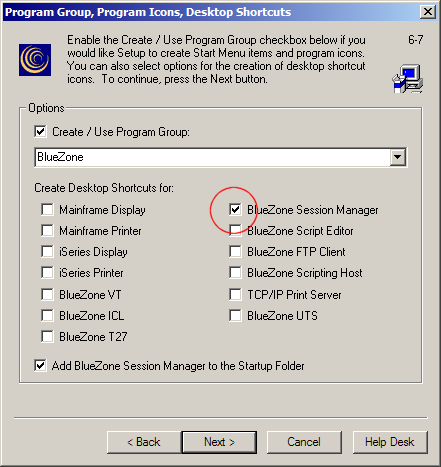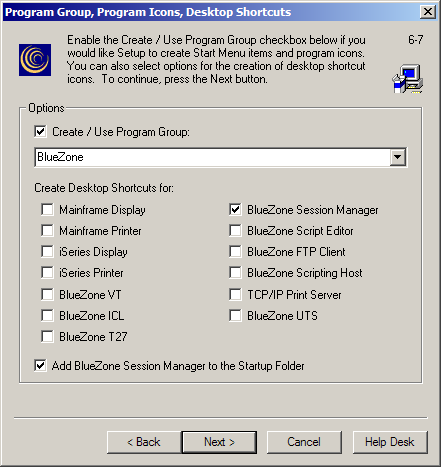
|
Installing BlueZone |
Chapter 2 |
The following installation procedure describes a basic BlueZone desktop installation performed directly from the BlueZone CD-ROM. It does not describe any of the advanced features that can be controlled by the BlueZone Administrator.
Performing a basic desktop installation is a great way for new Customers or evaluators to become familiar with BlueZone’s emulation client features. Please keep in mind, that BlueZone has additional advanced installation and administration features other than what is described in this chapter.
SEE Chapter 5 - Configuring BlueZone, for more information on advanced configuration options.
SEE Chapter 6 - Administering BlueZone, for information on distributing BlueZone to a wide number of users.
Existing Installations - If you already have BlueZone version 3.2 or earlier installed, please review the following Upgrade Procedure before proceeding.
Also, you should read Chapter 3 - BlueZone Modes of Operation first, before performing the installation.
NOTE If you are not upgrading a previous version of BlueZone, you can go directly to the Installation Procedure. Otherwise please read the following Upgrade Procedure.
Upgrading BlueZone is very simple. All you have to do is install the new version of BlueZone right on top of your current version. Your BlueZone configurations will be preserved and automatically upgraded to the new version.
Important! - Please be aware that starting with version 3.3, BlueZone now defaults to Profile Mode. Prior to version 3.3, the default mode for BlueZone was Registry Mode. In Registry Mode, all your BlueZone session configurations were stored in the Windows registry. In Profile Mode, all your session configurations are stored in files called Profiles. To convert to Profile Mode, all you have to do is install BlueZone (using the default settings) on top of your current installation, and BlueZone will automatically convert your Registry settings to Profiles. The BlueZone Session Manager is the program that actually performs the conversion.
During the installation you will receive the following message:

Illustration 2-1
 TIP
You may
want to read Chapter 3 - BlueZone Modes
of Operation first, before performing the upgrade.
TIP
You may
want to read Chapter 3 - BlueZone Modes
of Operation first, before performing the upgrade.
If you are converting from Registry Mode to Profile Mode, you may want BlueZone to automatically convert your BlueZone configuration Registry entries into Profiles. Profile Mode is the recommended mode for BlueZone. To take advantage of the automated conversion, make sure that you enable the new BlueZone Session Manager in the Program Group, Program Icons, Desktop Shortcuts dialog, during the upgrade, as shown in the following illustration:

Illustration 2-2
We recommend that you do not use the Desktop Shortcuts to launch BlueZone sessions. Instead, use the new Session Manager to launch your sessions. Keep in mind that if you already have BlueZone desktop shortcuts on your desktop, they will remain even if you have them un-checked in the above dialog.
SEE Chapter 4 - BlueZone Session Manager, to learn more about the new BlueZone Session Manager.
By using the new Session Manager, BlueZone will automatically convert your BlueZone configuration Registry entries into Profiles. The following naming format will be used:
|
BlueZone Session |
Profile Name |
|
Mainframe Display, Session 1 |
Mainframe Display S1.zmd |
|
Mainframe Printer, Session 1 |
Mainframe Printer P1.zmp |
|
iSeries Display, Session 1 |
iSeries Display S1.zad |
|
iSeries Printer, Session 1 |
iSeries Printer P1.zap |
|
BlueZone VT, Session 1 |
VT S1.zvt |
|
BlueZone FTP, Session1 |
FTP T1zft |
If you have more than one session defined, the file name will be named accordingly. For example, Mainframe Display Session 2 will be named Mainframe Display S2.zmd.
Later, when you launch a BlueZone session for the first time, will see that in Profile Mode, BlueZone places the name of the Profile in the upper left hand corner of the emulator, immediately to the right of the session number. If you wish, you can change the name of the Profile to a name that is more meaningful.
If you are ready to upgrade, continue with the following Desktop Installation Procedure.
When the installation is complete, launch the new BlueZone Session Manager to convert your BlueZone configuration Registry entries into Profiles. Your BlueZone Registry entries will be automatically removed.
BlueZone is provided on a CD-ROM. The installation follows standard Windows installation procedures.
Insert the BlueZone CD-ROM into your CD drive. The BlueZone CD will automatically launch the Welcome to BlueZone "Splash" screen:

Illustration 2-3
With your mouse, click the BlueZone Desktop button then the BlueZone Desktop Link as shown here:

Illustration 2-4
The BlueZone Setup program will display the following BlueZone Installation Dialog. Leave the Workstation Installation radio button selected and click the Next button.

Illustration 2-5
SEE Chapter 6 - Administering BlueZone, to learn more about the Network Server Installation (to allow users to share BlueZone files from a single network directory) and Creating a Distribution Image options.
The BlueZone Software License Agreement dialog will display. Answer as appropriate then click the Next button.

Illustration 2-6
We recommend that you let BlueZone determine the correct Installation Drive and Directory and the Working Drive and Directory. Click the Next button.

Illustration 2-7
NOTE If you are an experienced user, you can manually enter the appropriate paths or browse to these paths as needed.
NOTE If you are installing BlueZone on a Windows 2000 or Windows XP workstation that will be shared by more than one user, use the default value "Always use the Personal Folder as the Working Directory" checkbox so that each user can store their own settings and configurations and files.
or
If you want all users of this workstation to share the same settings, un-check the “Always use the Personal Folder as the Working Directory” checkbox and check the “Always use the All User’s Common Folder as the Working Directory” checkbox.
Select the BlueZone Components to be installed. To prevent a component from installing, un check the appropriate check box. Click the Next button.

Illustration 2-8
Select the Preferred Connection Type then click the Next button.
NOTE This value will be used as the default for all future session configurations. However, it may be changed anytime during individual session configurations.

Illustration 2-9
Select the desired Program Group, (BlueZone is the default). If you are going to use the BlueZone Session Manager for launching BlueZone sessions (highly recommended), it is not necessary to create any desktop shortcuts except for the Session Manager itself. If you want the BlueZone Session Manager to automatically start when Windows starts, leave the “Add BlueZone Session Manager to Startup Folder” option checked, then click the Next button.

Illustration 2-10
Click the Next button. The Launch Selected Items dialog will be displayed. Choose any items that you want to be launched immediately after the installation is completed.

Illustration 2-11
Click the Finish button. The selected BlueZone files will be installed, the BlueZone Program Group will be created, desktop shortcuts will be created and a message box letting you know that the installation was completed successfully will appear.

Illustration 2-12
Click the OK button. You will immediately receive the following message.

Illustration 2-13
If you have a valid BlueZone License in the form of a SEAGULL Activation File (seagull.saf), copy it to the place where your BlueZone files were installed. In this example, BlueZone was installed in C:\Program Files\SEAGULL\BlueZone. Your message (like the one shown above) will contain the exact location where your SAF file must be copied.
Click the No button to finish the installation. Once your SEAGULL Activation File is in place, and you launch a BlueZone session, BlueZone will use the information contained in the SAF file to determine your BlueZone license status.
Congratulations! Your BlueZone Desktop installation is complete. You can now launch BlueZone from any of the desktop shortcuts that were created during the installation process.
NOTE To Single User License Holders - If you have purchased a BlueZone Single User License, you will not receive a SAF file, you will receive a BlueZone Installation Key instead. Single User License holders must run the SEAGULL Registration Wizard to complete the installation process.
To run the SEAGULL Registration Wizard, click the Yes button and proceed to the next section, SEAGULL Registration Wizard.
The process to un-install BlueZone is very similar to the install process. Un-installation is accomplished using the BlueZone Setup program.
To un-install BlueZone, follow these steps:
Insert the BlueZone CD-ROM into your CD drive. The BlueZone CD will automatically launch the SEAGULL BlueZone Software "Splash" screen:

Illustration 2-14
With your mouse, click the BlueZone link then the BlueZone Desktop Link as shown:

Illustration 2-15
The BlueZone Setup program will display the following BlueZone Installation Dialog. Select the Uninstall the BlueZone Software radio button and click the Finish button.

Illustration 2-16
You will receive the following Remove User Data message.

Illustration 2-17
If you want to preserve your user data files such as Macros, Scripts and Configuration files, then click the No button. If you want to remove all BlueZone files including the user data files, then click the Yes button.
You will receive the following BlueZone Uninstall message.

Illustration 2-18
If you don't want to delete the BlueZone Program Group, then click the No button. If you want to delete the BlueZone Program Group, then click the Yes button.
When the uninstallation is complete, you will receive a message that the "BlueZone uninstallation completed successfully."
Distributing BlueZone to End Users
Creating a Shared Network Installation